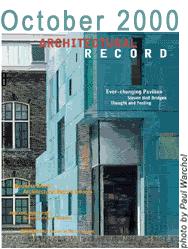 Reading “In Holland, the Shock of the New,” [July 2000, page 128], I was very affected to learn that this nation, where “almost everyone lives in well-designed dwellings with good light,” is “in the midst of an enormous government-sponsored . . . effort to build a million new units of housing by 2010.” As a New York architect who passes homeless people every day, I feel deeply angry and ashamed that our country—which has such vast wealth and resources, including so many architects capable of designing well-built, beautiful homes for all Americans—is doing so little to remedy this shameful, totally unnecessary situation.
Reading “In Holland, the Shock of the New,” [July 2000, page 128], I was very affected to learn that this nation, where “almost everyone lives in well-designed dwellings with good light,” is “in the midst of an enormous government-sponsored . . . effort to build a million new units of housing by 2010.” As a New York architect who passes homeless people every day, I feel deeply angry and ashamed that our country—which has such vast wealth and resources, including so many architects capable of designing well-built, beautiful homes for all Americans—is doing so little to remedy this shameful, totally unnecessary situation.
I learned from Aesthetic Realism, the education founded by the great philosopher and critic Eli Siegel, that the one reason homelessness exists is because a person’s need for a home is seen as a means for someone else to make a profit. This is contempt, which he defined as “the addition to self through the lessening of something else.” In a series of lectures beginning in 1970, Mr. Siegel showed that economics based on contempt is so inefficient, it can no longer work. Today, despite all the fakery about how “booming” it is, an economy that cannot provide decent housing for all our citizens is an utter failure.
The housing crisis will end and we, as architects, will feel truly useful and proud when we, when government leaders—when all Americans—ask and honestly answer this kind, crucial question first asked by Mr. Siegel: “What does a person deserve by being alive?” This question was the basis of an important continuing-education seminar I was proud to moderate at this year’s national AIA convention in Philadelphia, “Housing: A Basic Right, an Urgent Need, an Architectural Priority,” now on the convention Web site, www.aiaconvention2000.com.
Dale Laurin, AIA
New York City

